

World Service - Home. Tim Berners-Lee: The next web. Index. Linked swissbib - swissbib. The project linked.swissbib.ch aims to integrate the metacatalog swissbib into the semantic web, with the creation of a Linked Data service.
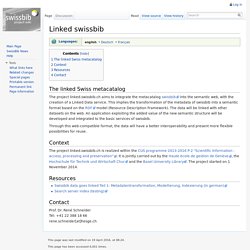
This implies the transformation of the metadata of swissbib into a semantic format based on the RDF model (Resource Description Framework). The data will be linked with other datasets on the web. An application exploiting the added value of the new semantic structure will be developed and integrated to the basic services of swissbib. PREMIS: Preservation Metadata Maintenance Activity. The PREMIS Data Dictionary for Preservation Metadata is the international standard for metadata to support the preservation of digital objects and ensure their long-term usability.
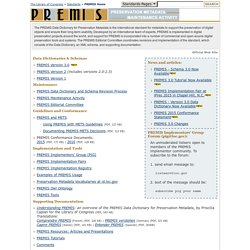
Developed by an international team of experts, PREMIS is implemented in digital preservation projects around the world, and support for PREMIS is incorporated into a number of commercial and open-source digital preservation tools and systems. The PREMIS Editorial Committee coordinates revisions and implementation of the standard, which consists of the Data Dictionary, an XML schema, and supporting documentation. Asbl - L'avenir par le numérique. Autonomous eXchange packages for Interoperable Systems Jointly with the IASA-OK strategic task force (International Association for Sound and Audiovisual Archives – Organizing Knowledge), TITAN has conducted a 8 years of conceptual and prototyping research on a conceptual model coping with the evolution of the place of the archives in the digital semantic era; coping with the incorporation of the old analog archives and coping with the Internet of Things.

The research started in 2006 by collaboration with the UNESCO in the Memories project consortium, one of whose objectives was to achieve such a conceptual model that could meet the real needs of the Memory of the World program. Titan asbl - L'avenir par le numérique. The CIDOC CRM. NewsML-G2 - IPTC. News Exchange is … … a method of conveying not only the core news content, but also data that describe the content in an abstract way (i.e. metadata), information about how to handle news in an appropriate way (i.e. news management metadata), information about the packaging of news information, and finally information about the transfer of news content.
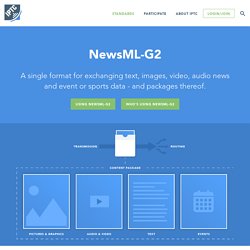
NewsML-G2 provides exchange formats for: General news: textual news, articles, photos, graphics, audio and video can be exchanged – the News ItemA flexible mechanism for packaging news in a structured way – the Package ItemInformation about concepts, used for values in controlled vocabularies – the Concept Item – and further a format to exchange full controlled vocabularies as a single file – the Knowledge ItemA means to convey editorial planning to customers – the Planning Item A wrapper around items to transmit them by any electronic means – the News Message. Ontology for Media Resource 1.0. 1 Introduction This section is informative, except those parts that are explicitly defined as normative.
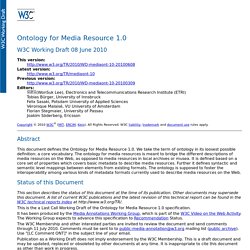
This document defines the Ontology for Media Resource, version 1.0. In this document, the term "ontology" is used in its broadest possible definition: a core vocabulary. The ontology for media resource describes a core vocabulary of properties and a set of mappings between different metadata formats of media resources hat describe media resources published on the Web (as opposed to local archives, museums, or other non-web related and non-shared collections of media resources).
The purpose of these mappings is to provide metadata representations that describe the characteristics and behavior of media resources in an interoperable manner, thereby enabling different applications to share and reuse these metadata. W3C Media Annotations Working Group. [ Mission .
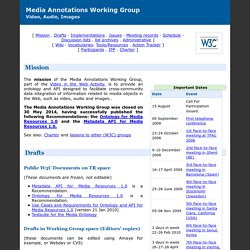
Drafts · Implementations . Issues · Meeting records · Schedule · Discussion lists . list archives . Administrative ] [ Wiki · Vocabularies· Tools/Resources . Action Tracker ] [ Participants . IPP . Mission. Linked Data - Design Issues. Up to Design Issues The Semantic Web isn't just about putting data on the web.
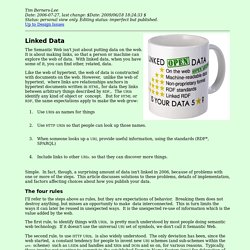
It is about making links, so that a person or machine can explore the web of data. With linked data, when you have some of it, you can find other, related, data. Tim Berners-Lee: The next web. International Association of Sound and Audiovisual Archives. Functional Requirements for Bibliographic Records. By IFLA Study Group on the Functional Requirements for Bibliographic Records Series: IFLA Series on Bibliographic Control 19 Publisher: Munich: K.G.
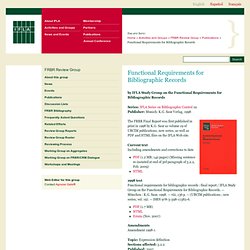
Saur Verlag, 1998 The FRBR Final Report was first published in print in 1998 by K.G. Saur as volume 19 of UBCIM publications, new series, as well as PDF and HTML files on the IFLA Web site. Current text Including amendments and corrections to date 1998 text Functional requirements for bibliographic records : final report / IFLA Study Group on the Functional Requirements for Bibliographic Records. — München : K.G. PDF (1.7 MB) HTML Errata (Nov. 2007) Amendments. Home - Perfect Memory. La Mémoire du monde à l'ère du numérique : numérisation et conservation. L'UNESCO a organisé, en collaboration avec l'Université de la Colombie-Britannique (Canada), une conférence internationale qui s’est tenue du 26 au 28 septembre 2012 à Vancouver, au Canada.
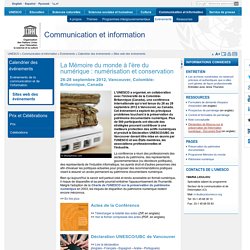
Cet événement a exploré les principaux problèmes touchant à la préservation du patrimoine documentaire numérique. GitHub - dhlab-basel/Knora: Knowledge Organization, Representation, and Annotation. Knowledge Organization, Representation and Annotation. Welcome - the Datahub. Ontology for Media Resources 1.0. This section describes the status of this document at the time of its publication.
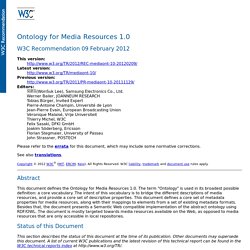
Other documents may supersede this document. A list of current W3C publications and the latest revision of this technical report can be found in the W3C technical reports index at This document has been reviewed by W3C Members, by software developers, and by other W3C groups and interested parties, and is endorsed by the Director as a W3C Recommendation. It is a stable document and may be used as reference material or cited from another document.
W3C's role in making the Recommendation is to draw attention to the specification and to promote its widespread deployment. EBU Technology & Innovation - Search Results. The Music Ontology. Assertion. Que ce soit pour vérifier une orthographe, une conjugaison, trouver une définition, un synonyme ou une citation, ce dictionnaire répond à tous vos besoins quotidiens en faisant une recherche par saisie de mots. Un dictionnaire de 90 000 mots et abréviations Plus de 135 000 définitions avec toutes les nuances de sens L’étymologie et de nombreuses indications d'usage 140 000 synonymes, homonymes et contraires 34 000 expressions et locutions formées avec le mot 9 000 citations d’auteurs français et étrangers 6 000 articles pratiques pour déjouer les pièges de la langue La conjugaison de tous les verbes (à tous les temps et à tous les modes).
Télécharger sur l'AppStore pour 5,49 € Cette application est universelle, une fois achetée, vous pouvez l'installer sur votre iPhone, iPod Touch ou iPad sans frais supplémentaires pour une interface adaptée à chaque appareil. Web sémantique. Comprendre le web sémantique. Le Web sémantique, ou « langage naturel » est le Saint Graal sur lequel planchent les chercheurs depuis quelques années. Pour un de ses théoriciens, Tim Berners-Lee, l'idée est de parvenir à un Web intelligent, où les informations ne seraient plus stockées mais comprises par les ordinateurs, pour apporter à l'utilisateur ce qu'il cherche vraiment.
Le Web sémantique permettra donc de rendre le contenu sémantique du Web interprétable non seulement par l'homme, mais aussi par la machine. L'idée est donc de permettre une recherche intelligente sur le Web, faite par des ordinateurs et basée sur des définitions qu'ils puissent « comprendre », des définitions données pour le monde entier. En faisant une requête sur un moteur proposant de la recherche en langage naturel, vous l'interrogerez comme vous parlez, et il transformera cette demande en langage compréhensible et cohérent pour la machine. Web sémantique. VIAF.